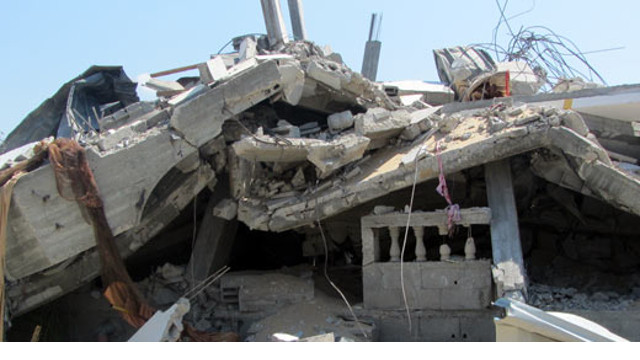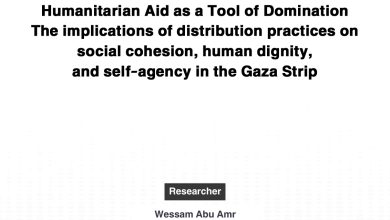UN Mechanism for Gaza Reconstruction is Recipe for a Fourth War

Background:
Gaza has been subjected to three Israeli military offensives in just six years, locking it into a cycle of building, destruction and rebuilding. Fueling the hostilities is a seven-year blockade of Gaza that has halted most exports and severely restricted both imports and human traffic. The summer war (July 8-August 26) came less than two years after “Operation Pillar of Defense“ — a war between Israel and the hamas movement and other military groups in Gaza that lasted for eight days (November 16-22, 2012) – and less than five years after “Operation Cast Lead,” which persisted for 22 days (December 27, 2008, to January 17, 2009). The UN estimates that more than 96,000 homes were damaged or destroyed in the latest war, leaving approximately 108,000 residents homeless – forced to find shelter in schools, with relatives or among the ruins. Seven months have already passed since an uneasy ceasefire brought to an end of the 51-day war that laid waste to much of the Gaza Strip. After falling off the world’s radar, the densely packed enclave of 1.8 million Palestinians is edging back into the news, however. A trickle of reporting has begun noting the lack of progress on reconstructing the massive damage to homes, hospitals, schools and businesses which keeps Gaza to be the biggest threat to stability in the region . Many credible security and political reports estimate that the next round of confrontation is a matter of time due to lack of progress and the great frustration amongst Gaza population. The reality is directly related to the consequence of the UN’s mechanism for implementing the reconstruction of Gaza, created by its special coordinator for the Middle East peace process, Robert Serry.
UN Mechanism for Gaza Reconstruction:
Because the Israeli government insists on assurance that none of the construction materials can be used by Hamas to rebuild its tunnels or restore its military equipment, and because the PA has only a weak presence in Gaza, the United Nations developed a cumbersome, complex mechanism for monitoring and approving these imports. The process is administered by a triangulated committee of the UN, the PA and the Israeli army. Cameras were installed to monitor raw material storehouses, as well as to track every truck carrying these materials –steps designed to ensure that Hamas is not a recipient. However, despite the pervasive reach of the mechanism, it has not been fully explained to the public, and no documents are available to do so. The result is an environment of doubt and distrust.
Implications of UN Mechanism:
Some reports have suggested that in effect, this mechanism legitimizes and internationalizes the Israeli blockade of Gaza, rather than work to lift it. It is certain that the UN mechanism, which employs a large contingent of foreign experts (as many as 400), will be a huge financial, administrative and security burden, thus prolonging the reconstruction process for many years. It also means the reconstruction process is driven by the UN, rather than by the PA. Thus, if the mechanism was actually effective (unlike its performance to date), the Palestinian people would praise the UN rather than the PA, depriving the latter of a unique opportunity to restore its reputation and popularity in the Gaza Strip. Even more alarming is the that supplies ordered to rebuild or repair both private homes and large-scale public works – including schools and factories – must be entered into a central tracking database.
Evaluation of UN Mechanism in Practice:
The first shipment of construction materials was allowed into Gaza when UN Secretary General Ban Ki-moon visited on October14 2014 . A total of 640 tons of cement were allowed into Gaza, the first time that the Israeli government had allowed construction material to enter the Strip in three years. The flow of construction material into Gaza has continued since then, but at a very slow rate. As of March, only 50,000 tons of cement had been allowed in, compared to the needed 1.5 million tons of cement, 5 million tons of aggregate and 500,000 tons of steel. At that pace, Gaza reconstruction would not be complete for 20 years.
More importantly, there are many credible reports that all construction materials allowed into Gaza to date have been sold on the black market to unknown buyers. The UN mechanism clearly has proven to be ineffective. Not only are members of Hamas able to buy imported cement “underground,” but they also can use the 2 million tons of rubble and thousands of tons of scrap steel created by the Israeli aggression to reconstruct the tunnels. The US mechanism has opened unlimited window for corruption, bad management and favoritism . The UN reconstruction mechanism has contributed to huge frustration and anger among all sectors of the people of Gaza, across all political parties.
Missed Opportunities:
The open-ended truce between Hamas and Israel on the one hand and the flawed UN mechanism to reconstruct Gaza on the other have left the door open for another round of violence and prolonged suffering. This situation also has closed the door to unique opportunities to:
• Strengthen Palestinian unity and the reconciliation government. The coalition government formed on June 2 badly needs to enhance its popularity with the provision of efficient, effective services. With the ineffective UN mechanism, people in Gaza do not feel grateful to their political system.
• Defuse tension, anger and frustration among the Gaza population, which would create the supportive environment needed to avoid extremism and radicalism.
• Engage Hamas and other political movements in the political system and encourage the trend toward moderation that had emerged in the past few years.
What Way Forward?
In a Brookings Institute policy paper I co-authored with Dr. Sultan Barakat called “The Case for a Collaborative Council for Gaza’s Reconstruction, ”we recommended what we believe would be not only the most efficient, but the most just, method for managing reconstruction. We called for the formation of a collaborative and representative higher body responsible for the entire process of reconstruction. This body would be chaired by an independent individual who is trusted by all sides and include representatives of the key stakeholders, including:
• The Palestinian coalition government.
• Four or five regional countries (likely Egypt, Jordan, Saudi Arabia, Qatar and Turkey).
• The European Union, World Bank and Islamic Development Bank.
• Civil society groups (two or three, with no political affiliation).
• Palestinian political factions, including Hamas and Islamic Jihad.
• Relevant UN agencies, mainly UNRWA and UNDP.
The reconstruction of the Gaza strip is not just a process of rebuilding houses; it should be national process to renovate the Palestinian political system completely and build bridges over the economic and psychological gaps between the political system and the Palestinian people in the Gaza strip and the West Bank .This body would ensure that the benefits of reconstruction were shared transparently among the population of Gaza in an equitable way — based only on established needs, not on political allegiances to one side or another. Furthermore, working around the same table would inevitably result in the various Palestinian factions entering into a dialogue with each other around issues of substance, and would hopefully lead to a wider national dialogue process.
This more inclusive, collaborative process still can be initiated in place of the deeply flawed UN mechanism. However, conditions on the ground in Gaza are increasingly desperate every day, and if relief does not come quickly, a new war may come first. If the international community is to avoid another bloody war, it must stop holding the Palestinians of Gaza hostage and either quickly change course with a more collaborative, inclusive reconstruction mechanism, or deal directly with the government that currently exists. If not, the blood of thousands of innocents again will be on its hands.





